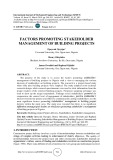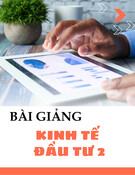
http://www.iaeme.com/IJM/index.asp 127 editor@iaeme.com
International Journal of Management (IJM)
Volume 10, Issue 2, March–April 2019, pp.127–134, Article ID: IJM_10_02_012
Available online at http://www.iaeme.com/ijm/issues.asp?JType=IJM&VType=10&IType=2
Journal Impact Factor (2019): 9.6780 (Calculated by GISI) www.jifactor.com
ISSN Print: 0976-6502 and ISSN Online: 0976-6510
© IAEME Publication
MANAGEMENT OF INNOVATIVE ACTIVITY
OF THE RUSSIAN ORGANIZATIONS ON THE
BASIS OF SCENARIO APPROACH
Dr. Julia V. Fedorova
Doctor of Economics Sciences, Professor, I.M. Sechenov First Moscow State Medical
University (Sechenov University), Russia, Moscow
Dr. Dmitry S. Roshchin
Epidemiologist
АО «European Medical Center» Russia, Moscow
Dr. Natalia L. Borscheva
Associate Professor, I.M. Sechenov First Moscow State Medical University
(Sechenov University), Russia, Moscow
Dr. Marina I. Glukhova
Associate Professor, I.M. Sechenov First Moscow State Medical University
(Sechenov University), Russia, Moscow
ABSTRACT
The article proposes a new methodological approach to assess the impact of
external factors on the innovative activity of Russian organizations. The identification
of such factors is necessary to improve the management of innovative organizations in
Russia. The authors assess the factors of the external environment of innovative
organizations. The correlation model is constructed and the key factors influencing
innovative activity of the Russian organizations are revealed. A regression model
reflecting the dependence of the level of innovative activity of organizations on changes
in the external environment in the dynamics from 2005 to 2016 is constructed. Four
variants of the scenario of changes in the number of innovative organizations in the
Russian economy under the influence of external factors are constructed.
Key words: innovative organization, innovative activity, innovative development,
management, external environment factors.
Cite this Article: Dr. Julia V. Fedorova, Dr. Dmitry S. Roshchin, Dr. Natalia L.
Borscheva and Dr. Marina I. Glukhova, Management of Innovative Activity of the
Russian Organizations on The Basis Of Scenario Approach, International Journal of
Management, 10 (2), 2019, pp. 127–134.
http://www.iaeme.com/IJM/issues.asp?JType=IJM&VType=10&IType=2

Dr. Julia V. Fedorova, Dr. Dmitry S. Roshchin, Dr. Natalia L. Borscheva and Dr. Marina I. Glukhova
http://www.iaeme.com/IJM/index.asp 128 editor@iaeme.com
1. INTRODUCTION
Today in Russia there is a low innovative activity of enterprises and organizations. The diagram
(figure 1) shows the indicators of innovative activity of Russian companies in dynamics
(Innovation statistics, 2017).
Figure.1 Innovative activity of Russian companies in dynamics from 2005 to 2016
To increase innovation activity and susceptibility to innovation of Russian organizations,
the authors of this study propose to assess the impact of external conditions, to determine the
factors that have the greatest and least impact on innovative organizations.
The external environment provides opportunities for any company to organize its successful
activities, as well as the necessary resources to maintain the company's potential. The
management of the enterprise needs to control the relationship with external factors, as the
company is in close interaction with the external environment, both in the production process
and in the process of implementation. There are four main characteristics of the external
environment.
First, it is a difficulty. The complexity is due to the number of factors affecting the company.
Complexity is an element that characterizes the number of environmental factors and the
relationship between these factors. The external environment in terms of complexity can be
classified as: homogeneous (simple environment) in which there is not a large number (3-4)
similar elements of the external environment affecting the organization, and heterogeneous
(complex environment), which contains many heterogeneous elements of the external
environment of the company, affecting the organization, and are in close interaction with the
company.
A homogeneous environment is more predictable for the Manager, which simplifies the
process of development and management decision-making. The multiplicity and uniqueness of
the factors influencing the activities of the organization is the number of significant objects, as
well as their close connection with the activities of the organization.
The difficulty lies in the fact that the company must deal with a wide range of factors, the
close connection with the activities of which is not always certain but is of great importance.
Secondly, it is the interconnectedness. The content of the element of interconnectedness is
that the impact of some factors has an impact on the changes of others, and there is a degree of
these changes. Interconnectedness of factors is the basic characteristic that determines the
relationship between the company's activities and the impact of the external environment.
Dependence or independence shows the density of the relationship of the company's activities
with the external environment.
Isolation is also an indicator of the relationship between structures in the external
environment. An isolated environment is peculiar by an unstable structure of communication
with the subjects, or their absolute absence.

Management of Innovative Activity of the Russian Organizations on The Basis Of Scenario
Approach
http://www.iaeme.com/IJM/index.asp 129 editor@iaeme.com
The company in its activities, as a rule, is always in interaction with customers, partners,
suppliers, consumers, competitors. At the same time, any company in its activities strives for
maximum independence.
Third, uncertainty. The essence of the uncertainty element is the degree of ownership of
information about changes in the environment, as well as the degree of confidence in the
reliability and accuracy of the information received.
A situation in which the company does not have sufficient information on the status and
trends of external factors of Seda increases the risk of unsatisfactory performance of the
company as a whole.
Fourth, variability. By its nature, the element of variability is to determine the mobility of
environmental factors.
For the successful functioning of any company, the most important thing is the stability of
relations with the external environment. In situations where there is a high level of complexity
and mobility of the environment, then to solve these problems, management needs to rely on
information obtained from different sources, as well as be able to change their own priorities.
In some cases, to make successful decisions, it is important to be able to revise the formed
system of values and culture of the company.
In the context of dynamic changes in environmental factors, it is necessary to carry out
regular monitoring and analysis of new strategies and approaches. This knowledge will allow
to make adequate and balanced decisions.
It should be marked that today there is no single established classification of factors
affecting the innovation of staff. Today, there are several opinions about what factors have an
impact on work motivation.
Several specialists classify factors only based on classification based on belonging to
external and internal, direct and indirect. Factors with indirect effects are more complex than
those with direct effects. For our research, indirect impact factors are of greater scientific
interest.
Factors of indirect influence of the external environment are classified into five groups,
while external factors experts include: political and legal (changes in the regulatory framework
and the political situation in the country), economic (General state of the economy, the state of
the labor market, capital, changes in working conditions), technological (changes in
technological standards, the development of technologies in the field of production and business
processes), social (social standards, ethnic norms, social values, social and psychological
factors), international (international migration, etc.).
The analysis of external factors needs conduct on an ongoing basis, as it accumulates
information that allows an assessment of the current situation.
Analysis of the external environment is the process by which the developers of strategic
innovation direction in the company keep under control external to the organization moments
to qualify threats and opportunities. The analysis of the external environment contains:
- Economic impact study,
- Study of the impact of legal regulation and management,
- Study of political processes,
- Study of the natural environment and resources,
- Research of social and cultural component of society,
- Research of scientific and technological development of society, infrastructure, etc.

Dr. Julia V. Fedorova, Dr. Dmitry S. Roshchin, Dr. Natalia L. Borscheva and Dr. Marina I. Glukhova
http://www.iaeme.com/IJM/index.asp 130 editor@iaeme.com
Qualitative analysis of the external environment can help to obtain meaningful results.
Eventually of timely carrying out of such analysis the organization receives:
- Time to predict probabilities,
- Time to draw up an intention in case of unexpected events,
- Time to develop an early warning system for probable hazards,
- Time to develop strategies that have all the chances to turn the former dangers into all
sorts of profitable opportunities.
2. MATERIALS AND METHODS
To determine the key factors influencing the development of innovative organizations in the
Russian economy, economic and statistical methods were used, in particular, correlation and
regression analysis was applied. Its task was to assess the degree of influence of environmental
factors on the number of innovative organizations in the Russian economy. In the course of this
study, political, economic, socio-demographic, technological, international factors affecting the
innovative activity of organizations (92 macro factors) were analyzed (Hochberg L., 2018;
Gorodnikova N., Hochberg L., 2018; Gorodnikova N, Gokhberg L., Ditkovskiy K, 2018 ). As
a result, the indicator "Number of innovative organizations" was chosen.
When performing the analysis, some methodological assumptions were made that are
significant from the standpoint of the interpretation of the results. Thus, the correlation and
regression analysis was performed at unbiased levels due to the short time series and the need
for empirical confirmation of the hypothesis of the relationship between the factors and the
resulting indicator for further research.
The selection of macro factors is performed according to the criterion of the greatest pair
correlation between them and the resulting indicator. The constructed correlation model
revealed a close connection of the resulting indicator with such factors as "Developed advanced
production technologies" (r= 0.92), "participation of organizations in joint international
innovation projects for research and development" (r=0.93), "New Russian technologies
(technical achievements) transferred to foreign and Russian organizations engaged in
technological innovations" (r = 0.98). Statistical data for the regression model is presented in
table 1 (Hochberg, L., 2018).
Tabel 1 Statistical data for creation of regression model
Innovative
organizations,
thousands of
units
(у)
Developed
advanced
production
technologies,
units
(х1)
Participation of
organizations in joint
international innovation
projects for research and
development, unit projects
(х2)
New Russian technologies
(technical achievements)
transferred to the Russian
and foreign organizations
which carried out
technological innovations,
units (х3)
2005
456
637
634
970
2006
456
736
705
991
2007
451
780
750
671
2008
448
787
811
830
2009
456
789
838
539
2010
458
864
886
848
2011
502
1138
1345
5527
2012
496
1323
1315
5628
2013
500
1429
1529
6282

Management of Innovative Activity of the Russian Organizations on The Basis Of Scenario
Approach
http://www.iaeme.com/IJM/index.asp 131 editor@iaeme.com
2014
483
1409
1521
4011
2015
499
1398
1771
6408
2016
511
1534
1685
5955
Correlation coefficient
0.92
0.93
0.98
To confirm the influence of the identified key factors (positive influence of factors x1, x2,
x3) on the resulting indicator, a regression model was built. Analysis of the factors in the macro
environment influencing the innovative activity of Russian enterprises and organizations in the
obtained regression model allowed to identify the trends of key factors in the macro
environment and to build a real model in the form of the formula:
y = 443,599+0, 00784x1-0, 0027x2+0,008562x3 (1)
х1 – developed advanced production technologies, units
х2 – participation of organizations in joint international innovation projects for research and
development, unit projects
х3 - new Russian technologies (technical achievements) transferred to the Russian and
foreign organizations which carried out technological innovations, units
In the constructed real (regression) model, the resulting indicator is positively influenced
by the factors "Developed advanced production technologies " (x1) and" New Russian
technologies (technical achievements) transferred to foreign organizations "(x3), and the factor
"Participation of industry organizations in joint international innovative projects for research
and development" (x2).
The negative impact of the factor (x2) can be explained by the fact that the number of joint
international innovative research projects involving industrial organizations is constantly
increasing, but the results are not always implemented in Russian organizations. The negative
impact of the second factor can be explained by the lack of effectiveness of joint research
projects.
The strategic development of innovative organizations is largely associated with changes in
the external environment and is determined by the scenario of changes in the external
environment. The study analyzed four possible scenarios: realistic (based on trends),
conservative, innovative, forced. The forecast values of the factors influencing the innovative
activity of enterprises and organizations in a realistic scenario were obtained by constructing
trend lines (linear, logarithmic, and polynomial). The coefficient of approximation (R²) was
used as a selection criterion results in the construction of trend lines in different ways.
The approximation coefficient (R²) became the criterion for selecting the result. For the
factor, x1, x2, x3, the trend lines are constructed in a polynomial way, since they have a higher
value of the approximation coefficient compared to the logarithmic and linear way (fig.2, fig.3,
fig.4).





















![Tài liệu Quản lý dự án: Kiến thức nền tảng toàn diện [chuẩn SEO]](https://cdn.tailieu.vn/images/document/thumbnail/2025/20250910/kimphuong1001/135x160/92631757496585.jpg)




